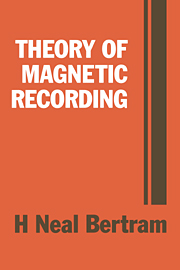Book contents
- Frontmatter
- Contents
- Preface
- 1 Overview
- 2 Review of magnetostatic fields
- 3 Inductive head fields
- 4 Medium magnetic fields
- 5 Playback process: Part 1 – General concepts and single transitions
- 6 Playback process: Part 2 – Multiple transitions
- 7 Magnetoresistive heads
- 8 Record process: Part 1 – Transition models
- 9 Record process: Part 2 – Non-linearities and overwrite
- 10 Medium noise mechanisms: Part 1 – General concepts, modulation noise
- 11 Medium noise mechanisms: Part 2 – Particulate noise
- 12 Medium noise mechanisms: Part 3 – Transition noise
- References and bibliography
- Index
3 - Inductive head fields
Published online by Cambridge University Press: 02 February 2010
- Frontmatter
- Contents
- Preface
- 1 Overview
- 2 Review of magnetostatic fields
- 3 Inductive head fields
- 4 Medium magnetic fields
- 5 Playback process: Part 1 – General concepts and single transitions
- 6 Playback process: Part 2 – Multiple transitions
- 7 Magnetoresistive heads
- 8 Record process: Part 1 – Transition models
- 9 Record process: Part 2 – Non-linearities and overwrite
- 10 Medium noise mechanisms: Part 1 – General concepts, modulation noise
- 11 Medium noise mechanisms: Part 2 – Particulate noise
- 12 Medium noise mechanisms: Part 3 – Transition noise
- References and bibliography
- Index
Summary
Introduction
In this section fields and Fourier transforms of a variety of inductive head configurations will be presented. The field patterns are of interest for both the recording process and, via reciprocity, the playback waveforms. First, the concept of head efficiency will be introduced. Following that, approximate and exact expressions for the fields in the gap vicinity of a very wide head will be derived and compared. The effect of finite head length as well as finite track width will be discussed in terms of approximate expressions. The results of studies of head field saturation will be included. The chapter will conclude with a discussion of the effect of keepered media on head fields.
The function of a recording head is to transfer efficiently the mmf that results from a current applied to the windings into field at the gap region where the recording medium passes. Two state-of-the-art structures are shown in Figs. 1.4 and 3.1. Figure 3.1 shows a head designed for highdata- rate recording in high-density helical scan tape recorders (Ash, et al., 1990). This structure exhibits the extreme dimensional scaling typical of most head structures: the gap length is sub micron (g ∼ 0.25μm), the gap depth and gap width are between one and two orders of magnitude larger (∼ 10–30μm), and the head major dimensions are in the mm range. The example in Fig. 3.1 is of a structure completely laminated to allow for operation at frequencies ∼150MHz. An inductive head, commonly of this geometry, is either completely ferrite for medium coercivity applications or ‘metal-in-gap’ for use on high coercivity media for video (8mm or DAT) or data recording (Jeffers, 1986; Iizuka, et al., 1988).
- Type
- Chapter
- Information
- Theory of Magnetic Recording , pp. 48 - 88Publisher: Cambridge University PressPrint publication year: 1994



